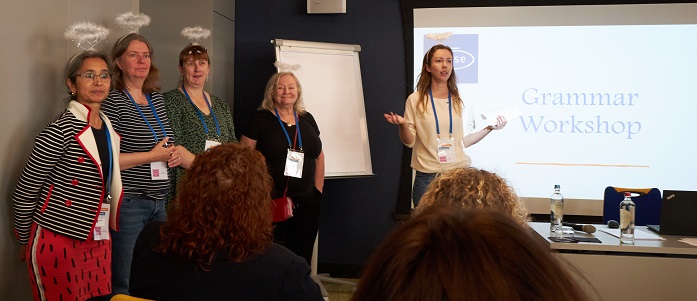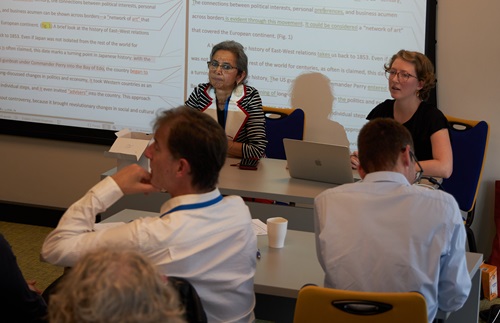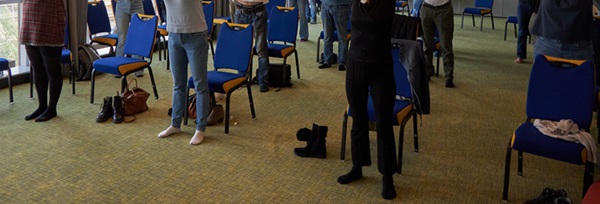
On Saturday 30 September, SENSE welcomed members and guests for their first in-person Professional Development Day (PDD) since 2019. Held in Park Plaza hotel in Utrecht on the Feast Day of Saint Jerome – the patron saint of translators – language professionals were greeted by the Room Angels, also known as the organizing team: Maaike Meijer, Naomi Gilchrist, Nandini Bedi, Kerry Gilchrist and Lizzie Kean, who showed everybody to their meeting rooms throughout the day.
The organizers put together a diverse programme of workshops and presentations, and there was something of interest for everyone. Attendees were welcomed with coffee, croissants and cake, in addition to a well-received buffet lunch, which gave everyone time to mingle.
Below are some session recaps. If you log in to our website, you’ll find an overview of all the workshops on the 2023 PDD conference page.
 Editing slam
Editing slam
Copy-editor and English teacher Nandini Bedi and copy-editor and proofreader Danielle N. Carter invited attendees to edit a humanities text written in English by a German scholar. This made for a lively interactive session.
The text was both poorly written and poorly organized, making it difficult to read and make sense of. Besides considerations such as changing the voice, e.g. from ‘this paper attempts to show’ to ‘I will show’, other issues were considered alongside the question of how far the text should be reorganized.
It was recommended that the editor request a sample of the source text before accepting an editing job. If the budget is tight, you may have to work out your client’s priorities and do less research. When giving feedback, you should strive to write cordial – but brief – comments to double-check with the author if your changes are acceptable and that the edit still reflects the intended meaning.
Attendees were particularly interested in the use of various software to speed up the editing process, in particular the Word plug-ins PerfectIt and Editor’s Toolkit Plus, together with macros such as JoinTwoWords, DocAlyse and HyphenAlyse. The Read Aloud function in Word was much praised by Nandini because it allowed her to check the flow of the text without the distractions of track changes. Another tip from Danielle was to rewrite various clients’ style sheets in your own standardized format for speedy reference.
Last but not least, the presenters and audience reflected on the crucial importance of communication outside of the editing process. For example, the presenters cautioned against contacting the author of a particularly troublesome piece for more information since lengthy email correspondence is not included in your quote. They trust your expertise and want you to make the text look respectable. To stress this, Nandini delivers work with the word ‘final’ in the filename.
Grammar & punctuation refresher
We can think of less intimidating things than presenting grammar and punctuation tips to professional language nitpickers, but Bristol-born Dutch-to-English translator Claire Niven executed the task with panache. The first part of the presentation focused on punctuation, with a strong attention to comma use, while the second part was about changing language conventions, such as singular ‘they’ and spelling issues related to race and ethnicity.
Claire covered four basic commas: the listing comma, the joining comma, the bracketing comma and the introductory comma, as well as the order of adjectives, which can be tricky. Native speakers subconsciously know the right order: determiner, observation or opinion, size, shape, age, colour, origin, material, and, finally, qualifier. If you would like to understand why ‘silver small spoon’ just does not sound right, you might enjoy reading ‘The Elements of Eloquence’ by Mark Forsyth.
Commas were just one of the language-related subjects that sparked a lively discussion. Hearing people’s different opinions and experiences helped those present to take more informed decisions on a variety of issues as the Oxford comma, the distinction between ‘which’ and ‘that’ in subordinate clauses and the singular ‘they’.
Race and ethnicity are hotly debated topics in contemporary societies and spelling can play a bigger role than you might think. Claire discussed capitalizing ‘Black’ (but not necessarily ‘White’), and noted that the term ‘Caucasian’ stems from outdated biological theories about race. ‘Person of colour (POC)’ is not as common in British English as in American English today, but like much of what we discussed, that may change in time. A highly recommended website in this regard is ‘The Conscious Style Guide’.
Transcreation
Despite facing technical difficulties, transcreation specialist Branco van der Werf delivered a captivating presentation in his own unique style on finding and keeping transcreation clients. Having specialized in translating creative marketing copy since 2014, Branco generously shared his insights from his chosen niche.
First and foremost, budding transcreation translators should not call their services transcreation, because that is what translation agencies call it. In Branco’s opinion, working on transcreation projects through translation agencies is not ideal. If you would like to work directly with marketers, you should search for marketing companies offering services called market internationalization, international copywriting or simply creative translation. Marketeers often specialize in either business to business (B2B) or business to consumer (B2C) marketing and you should consider which one suits you best, or whether you want to offer both. As a rule of thumb, B2B has a more corporate, objective style of writing, whereas B2C is more subjective and is about eliciting emotions.
When working with marketing agencies, it is vital not to undersell yourself. Focus on what is relevant to them – they are probably not interested in what computer-assisted translation (CAT) tools you use and probably assume that you are meticulous and will deliver on time. They are interested, however, in which marketing projects you have completed, and for which brands. Keep your first elevator pitch email to two or three lines to get them interested.
One effective way of keeping your new-found clients happy is writing memorable emails, and sharing your enthusiasm for the project and how it ties in well with your previous experience. Of course, high-quality translation – or ‘market internalization’ – makes every client happy. When translating taglines, give your client options to choose from, instead of rephrasing the same translation three times.
But being creative on demand can be hard if you have no inspiration. To get his creativity flowing, Branco likes to impose restrictions on himself, such as trying to rhyme, making the copy shorter or choosing a different grammatical subject. Puns and humour are another great avenue to explore. And even if you hate your own pun, it could put your creativity back on track.
How to write great copy
Business writing trainer Stephen Johnston gave a whistle-stop tour of what is normally a two-day workshop on copywriting in just 45 minutes.
This workshop was the epitome of ‘there is no try’ as Stephen quickly and skilfully wrangled copywriting issues out of attendees, which he marked on a whiteboard and revisited at the end of the presentation.
One of the main takeaways was that great copy needs to get into the reader’s head, and not just remain on paper. To do this, both general principles and specific ‘job aids’ can be used.
In general, write the way you talk. Talk about the benefits – and not your features – as a business or freelancer. Help the reader by providing short, goal-oriented, navigable copy that has a clear structure, good grammar and a strong take-home message. Other tips included the ‘rule of three’: stop, look and listen.
The importance of considering the order in which information is presented was emphasized, as well as using informational sub-headings (e.g. using ‘Sales increased by 50% in the 2nd quarter’ rather than just ‘Sales’).
In terms of job aids, SCOPE was the most important:
- Start – describe the reader’s current situation (that everyone can agree with).
- Change – introduce a problem to be solved.
- Overall question – identify the question posed by the change.
- Principal message – answer the question with a principal message.
- Explanation – briefly explain your supporting information.
In general, a masterful presentation with many actionable points for the audience.
Video game localization
If you think video games are for shy teenagers, think again. Video games are a multi-billion-dollar industry that is increasingly relevant to pop culture, just like cinema and music. Games go beyond entertainment and are also incorporated in e-learning, health and safety regulations, and to raise awareness on racism and cyberbullying. In his interactive and informative presentation, Melchior Philips, who has five years of experience as a video game translator, confirmed that many people prefer to play video games in their native language.
Everything in a video game has to be translated: from the characters’ dialogues and user interface to support materials and patch notes (technical notices on improvements in new updates) to texts about the game (online store pages, product descriptions and newsletters), and even terms of use and end-user licence agreements.
Most video games are produced in the US and Japan and often contain cultural references that warrant localization. You need a lot of creativity, especially since context and visuals are not always provided. For many game developers, translation is an afterthought. The lack of context is often countered by two rounds of quality assurance, one in collaboration with the developer to see if the translations work in the actual game, followed by a linguistic quality assurance with a reviewer.
Video game localization is hard work but good fun, and unfortunately, the fun is also reflected in the rates offered. Many video game translators will work with specialized translation agencies, which at least usually guarantees a steady flow of work.
Yoga while you work
Anne Hodgkinson was the last presenter with her yoga class, which was perfect timing after a long day of mostly sitting. Together, attendees tried a number of yoga exercises that can be easily squeezed in between tasks while working. Clearly, this was not the first yoga class Anne taught and with her skilled guidance, even complete novices experienced the beneficial effects of office yoga. Everyone’s body is different and you should always respect your limits, but some exercises were truly manageable for every language professional. Reinvigorated and relaxed, we headed down to the bar, knowing a few new ways to work more healthily and happily.

If you add Matthew Curlewis’ ‘Write to reconnect’, Anne Oosthuizen’s ‘Poetry and song translation’, Hanneke de Raaff’s ‘Music interpretation in sign language’, and Jenny Zonneveld’s ‘Creating an ergonomic workspace’, you’ll see that all in all it was a truly informative and splendid day.
Do you have an idea for a future online or in-person presentation? Or would you like to join the SENSE Continuing Professional Development (CPD) team? Please contact CPD@sense-online.nl.
|
Blog post by: Jasper Pauwels Website: www.pauwelstranslations.nl LinkedIn: jasperpauwels |
|
Blog post by: Tomas Brogan LinkedIn: tomasbrogan |

